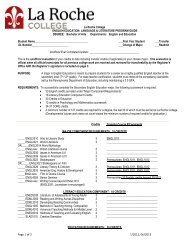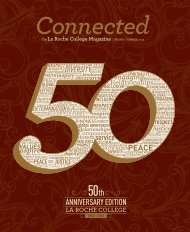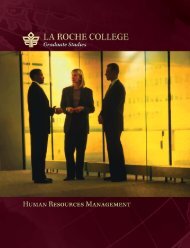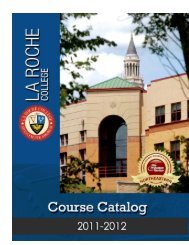Layout 1 (Page 2) - La Roche College
Layout 1 (Page 2) - La Roche College
Layout 1 (Page 2) - La Roche College
Create successful ePaper yourself
Turn your PDF publications into a flip-book with our unique Google optimized e-Paper software.
<strong>College</strong> President Contributes<br />
to Book on Women in Higher Ed<br />
by Pam Wigley<br />
The title of the introductory chapter within a textbook on women leaders<br />
in higher education says it all in one simple phrase – “Quiet Inspiration<br />
and Hard Work: The Impact of Women Administrators.” The authors,<br />
Jana Nidiffer and Carolyn Terry Bashaw, fill not only that chapter but also an entire<br />
book on the effects women administrators have had throughout history as they<br />
have taken leadership roles within some of the nation’s higher education<br />
institutions. Spurred by comments from a male student in her History of Higher<br />
Education Course, Nidiffer created a book titled Women Administrators in Higher<br />
Education: Historical and Contemporary Perspectives. Its insightful commentary<br />
through firsthand accounts provides a look at how women have moved from taking<br />
“crumbs from the boy’s table” (a chapter title) to leading a new generation of<br />
students who have benefitted from the female perspective.<br />
<strong>La</strong> <strong>Roche</strong> <strong>College</strong> President Sister Candace Introcaso, CDP, Ph.D., was one of 11<br />
women to contribute a chapter to the book. In “Determination in Leadership:<br />
Pioneering Roman Catholic Women Presidents,” Sister Candace writes about the<br />
women religious who have served as role models in higher education.<br />
“It’s critical to include the sister presidents when you are looking at history,” Sister<br />
Candace noted. “Trinity <strong>College</strong> in Washington, D.C., was the first college founded<br />
by women religious, and it was a monumental event that set an example.”<br />
In her chapter, Sister Candace provides an overview of the challenges faced by<br />
colleges founded and/or run by women. After seeing a posting requesting authors<br />
for the project, she wrote the commentary while serving as assistant vice president<br />
for academic affairs at Heritage <strong>College</strong>, located on the Yakima Indian Reservation<br />
in Toppenish, Wash. Having earned her master’s degree in sociology from Fordham<br />
University, Sister Candace was teaching when she realized that she enjoyed the<br />
administrative side of higher education. She then chose to continue her education,<br />
receiving her doctorate in higher education administration from The Claremont<br />
Graduate University. She joined the ranks of the women presidents about which<br />
she wrote when she became president of <strong>La</strong> <strong>Roche</strong> in 2004 following a stint as<br />
vice president for planning and assessment at Barry University in Miami Shores, Fla.<br />
“I don’t look at this as a job,” Sister Candace said. “I look at it as my ministry.<br />
I believe women religious bring something to higher education that no one else<br />
does. Perhaps it’s in reaching out to the underserved, and doing so with a<br />
foundation of faith, but it’s definitely different.<br />
“These women do what they are called to do with little fanfare, but they quietly<br />
and consistently provide an education for people who may not get it anywhere<br />
else. And that’s what’s inspiring to me.”<br />
Women Administrators in Higher Education: Historical and Contemporary<br />
Perspectives. was distributed by State University of New York Press. For more<br />
information, visit www.sunypress.edu.<br />
I<br />
Students Create Unique Artwork<br />
for Guest Speaker<br />
by Colleen Pelc<br />
(From left to right) Cari David, Jackie Sipos, Melanie Highberger, Suzanne Tick, Hillary<br />
Steger, Therese Nuttall, and Kelsey <strong>La</strong>ndis.:<br />
nterior Design students got to the “point” last fall when they made a<br />
unique piece of artwork for the 2008 Design Dialogue speaker, Suzanne<br />
Tick, of New York-based Suzanne Tick, Inc.<br />
“Freshmores” (second year students in a five-year program) Therese Nuttall,<br />
Kelsey <strong>La</strong>ndis, Melanie Highberger, Hillary Steger, Cari David and Jackie Sipos<br />
spent countless hours creating a pointillistic-style photo of Tick, that they then<br />
presented to her while she was visiting campus for the annual Design Dialogue<br />
event in October.<br />
The <strong>La</strong> <strong>Roche</strong> <strong>College</strong> Interior Design Advisory Board (IDAB) annually brings a<br />
nationally known design professional to Pittsburgh as part of its Design Dialogue<br />
Series, an event in which the designer delivers a presentation to the public and<br />
also spends time with the students in the Interior Design program. This year,<br />
more than 170 people were in attendance at the Carnegie Science Center in<br />
Pittsburgh to hear Tick’s presentation titled, “Revolution Reality – Paralleling the<br />
Design Revolution of the Sixties with Today.”<br />
To create the artwork, the students first enlarged a black and white photo of Tick<br />
to a poster size. Then using colored paper and a standard paper punch, they<br />
created more than 20,000 small colored dots. <strong>La</strong>stly, they glued the dots onto<br />
the photo to create the image.<br />
The artwork was on display in the Ryan Room during Tick’s student presentation,<br />
and also at the Carnegie Science Center during the public event.<br />
PHOTO: KRISNA POZNIK<br />
7
















